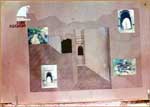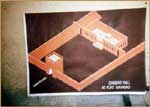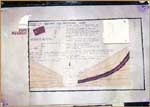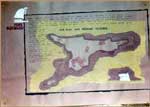Home >> Vaidic Research
Vaidic Research
I. Dedicated Researcher
Ar. Sanjay Mahashabde, an architect by profession, is a multifaceted personality. Since 1988, he is
practicing in the field and has designed and developed variety of structures. He worked as a chief Architect of
Rani Durgavati Vishwa Vidyalaya (Jabalpur University) for five years. He was a lecturer at Dept. of
Architecture in College of Engineering and Technology, Akola.
Though Ar. Mahashabde was busy in the professional field, his thirst for knowledge led him towards research in
architecture, astrology and Vaidic philosophy. He has dug deep into the 'Concept of Astronomy in ancient Indian
Architecture and its relevance with human comfort'. He has also presented a research paper on 'Concept of
energy concious architecture and its effects on human health, healing and comfort.' Ar. Mahashabde is engaged
in the ongoing research on 'The subtle energy fields, (morphogenic fields) grids and zones within and around
the building forms and materials.'
Ar. Mahashabde is practicing as a Vaastu Consultant for last 14 years. he has given special consultancy
services in over 5000 cases and has received encouraging feed back from his clients. The list of his esteemed
clients is increasing day by day.
Ar. Mahashabde is the founder member of a renowned national institute, Institution of Vaastu Sciences (IVS)'.
He is also a member of Indian Institute of Architects and Council of , India.
II. Research Papers
New Light On Ancient Wisdom .....
Space, Time and Architecher
Energy: The Forth Dimension of Architecture.
Architectural Wonders of Raigad Fort.
1989 March 27 to 29 - scientific literature in Sanskrit and Prakrit Launguages
1994 July 1 - "Vaastu" Energy concept
1994 Nov 9 - Industrial Architecture and Environment and it's relevance to VaastuShastra
1995 Feb - Vaastu as a Therapy
1996 - Vigyanbharti part 1
1996 - Vigyanbharti part 1 (Hindi)
1997 - Vigyan bharti- part-2
1997 - Vigyan bharti- part-2 (Hindi)
2000 Feb 11, 12, 13 - Concept of astronomy in ancient architecture
2000 Aug 18, 19, 20 - Navagrahas as Dikpals in vaastu
2002 June 1, 2 - Auspiwatch
2003 June 9 - Vaidic Approach to vaastu
2004 Feb 12, 13, 14, 15 - Auspiwatch
15, 16 & 17th Feb. 2008 - International Conference at Indore, M.P. Vaastu Panorama 2008. Organised by
Institution of Vaastu Science (IVS) Indore, MP, India
III. New Light On Ancient Wisdom .....
Ar. Mahashabde has deep faith in ancient Indian wisdom. It is a world renowned fact that Indians from
Vaidic period achieved magnificent feats in the fields of Mathematics, Astrology, Architecture, Sculpture
etc.
 Study
of architecture at fort Raigad, the capital fort of Chhatrapati Shivaji Maharaj, proved to be a
turning point in Ar. Mahashabde's life. He chose it as the subject for Thesis for B. Arch. though the
decision was severely criticised. He was fascinated by the fact that nearly four centuries ago, architects
and craftmen built a Royal Court, Darbar-E-Aam, using available energy very efficiently. In this court the
location of the Royal seat of Chhatrapati Shivaji Maharaj was uniquely selected according to Ancient Indian
architecture. From there, one person can address a gathering of 5000-6000 people even today, without the aid
of any device. Similarly, small whisper from any corner of the court can reach to the point of Royal Seat.
But just a couple of feet away from the Royal Seat, situation changes; not a word can be heard by the people
or any sound from the court cannot reach to the place where Maharaja's council of ministers used to sit.
This unparallel acoustic wonder fascinated Ar. Mahashabde.
Study
of architecture at fort Raigad, the capital fort of Chhatrapati Shivaji Maharaj, proved to be a
turning point in Ar. Mahashabde's life. He chose it as the subject for Thesis for B. Arch. though the
decision was severely criticised. He was fascinated by the fact that nearly four centuries ago, architects
and craftmen built a Royal Court, Darbar-E-Aam, using available energy very efficiently. In this court the
location of the Royal seat of Chhatrapati Shivaji Maharaj was uniquely selected according to Ancient Indian
architecture. From there, one person can address a gathering of 5000-6000 people even today, without the aid
of any device. Similarly, small whisper from any corner of the court can reach to the point of Royal Seat.
But just a couple of feet away from the Royal Seat, situation changes; not a word can be heard by the people
or any sound from the court cannot reach to the place where Maharaja's council of ministers used to sit.
This unparallel acoustic wonder fascinated Ar. Mahashabde.
He further dwelled deep and found out why coronation of Maharaj took place on that particular day. On that
day, sun rays reached directly to the spot where the Royal Seat (Sinhasan) was placed.
Noted historians and fort lovers Shri Ninad Bedekar, Shri. P. K. Ghanekar, Shri B. M. Alias Babasahed
Purandare and late Shri Mahadevshastri Joshi helped Ar. Mahashabde in his study of Raigad.
Ar. Mahashabde deduced that people of that time were in a know of a science or a theory, which has a blend
of astronomy, astrology, geography and topography. That science or theory has been conceived by Rishis or
sages of ancient India, to consider human beings and other things as a part of earth and universe
(Brahmanda). This thought has given rise to a science called 'Vaastushatra'.
Indian philosophy believes that the place where you stay or work affects the lives of its occupants. This
very idea led Ar. Mahashabde to create a new concept "Dikpals". The discovery of "Dikpals" is another
turning point in the life of Ar. Mahashabde. It is the first ever attempt to use the ancient wisdom in a
product which is effective and functional in modern times.
Ar. Mahashabde gratefully acknowledges the blessing of Mahamahopadhyay Yajneshwarshastri Kasture of
Chaturvedishwar dham Sawargaon and Shri Nagnath Shastri Inamdar of Bodhan who helped him with their sage
like wisdom to see the meanings in old scriptures and eventually to develop "Dikpals"
Ar. Mahashabde has done extensive research on ancient scriptures. He claims on the basis of his thorough
study that the Kutub Minar of Delhi was built by Varah Mihir, a pioneer in Mathematics and Astrology. This
tower was built to calculate and predict planetary positions, their speed etc.
Balaji Temple at Vashim in Akola is also built on similar principle. The deity in this temple also receives
direct sun rays on a particular day & this continues for six months.
Ar. Mahashabde has written no. of articles on Vishwakarma (the designer and planner of this universe,
according to Hindu mythology ), Varahmihir and his association with Kutub Minar, Nakshatra Bhuvan around
this tower and temple of Vashim. He provides citations from ancient scriptures to support his claim.
In May 1997, an earthquake rocked Jabalpur. Many buildings collapsed , but those buildings or homes,
erected knowingly or unknowingly, on the basis of ancient Indian science, Vastushartra, were less
damaged, observed
Ar. Mahashabde afer his visit for study to Jabalpur. He is propagating that cities should be designed and
developed according to Vaastushatra, to make it less vulnerable to natural calamities. He is trying to find
out what made ancient structures so strong, yet beautiful and functional and whether we can replicate such
structures in the modern world. He is also deeply involved in the concept of 'Vaastu.' The sages of ancient
India believed that stars and planets rule certain directions. Ar. Mahashabde is studying to unravel the
mystery of the co-relation among direction, its ruling planet, use of certain stones to enhance the good
effects and ward off bad effects of planets and other forces.
Some historical temples in India, such as Sun temple of Konark, Mahalaxmi Temple of Kolhapur, temple of
Renukadevi at Mahur are unique examples of architectural excellence. Statutes of deities in all these
temples are lit by rays either on a particular day or a particular period. That means architects, who
designed and built these temples must have studied obituary path of the Sun in different seasons,
throughout the year. Ar. Mahashabde claims that this can not happen unless there is a long tradition of
multidisciplinary study of Astronomy, Astrology, Architecture, Geometry and Mathematics.
Through his research in this field, Ar. Mahashabde has developed certain products. They are based on
age-old principles stated by Rishis of ancient India. Now a days, it is difficult to purchase a flat or
create a building which is flawless according to Vaastushatra. But we can lessen the bad effects if any and
enhance good effects of that Vaastu by using certain products, claims Ar. Mahashabde.



















 Study
of architecture at fort Raigad, the capital fort of Chhatrapati Shivaji Maharaj, proved to be a
turning point in Ar. Mahashabde's life. He chose it as the subject for Thesis for B. Arch. though the
decision was severely criticised. He was fascinated by the fact that nearly four centuries ago, architects
and craftmen built a Royal Court, Darbar-E-Aam, using available energy very efficiently. In this court the
location of the Royal seat of Chhatrapati Shivaji Maharaj was uniquely selected according to Ancient Indian
architecture. From there, one person can address a gathering of 5000-6000 people even today, without the aid
of any device. Similarly, small whisper from any corner of the court can reach to the point of Royal Seat.
But just a couple of feet away from the Royal Seat, situation changes; not a word can be heard by the people
or any sound from the court cannot reach to the place where Maharaja's council of ministers used to sit.
This unparallel acoustic wonder fascinated Ar. Mahashabde.
Study
of architecture at fort Raigad, the capital fort of Chhatrapati Shivaji Maharaj, proved to be a
turning point in Ar. Mahashabde's life. He chose it as the subject for Thesis for B. Arch. though the
decision was severely criticised. He was fascinated by the fact that nearly four centuries ago, architects
and craftmen built a Royal Court, Darbar-E-Aam, using available energy very efficiently. In this court the
location of the Royal seat of Chhatrapati Shivaji Maharaj was uniquely selected according to Ancient Indian
architecture. From there, one person can address a gathering of 5000-6000 people even today, without the aid
of any device. Similarly, small whisper from any corner of the court can reach to the point of Royal Seat.
But just a couple of feet away from the Royal Seat, situation changes; not a word can be heard by the people
or any sound from the court cannot reach to the place where Maharaja's council of ministers used to sit.
This unparallel acoustic wonder fascinated Ar. Mahashabde.


